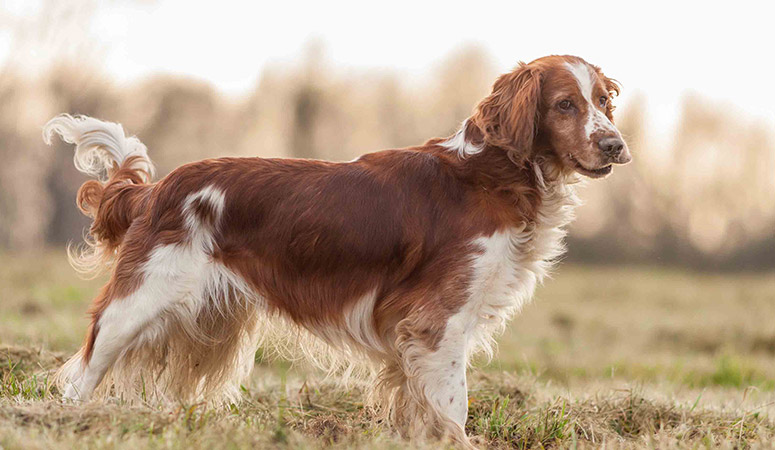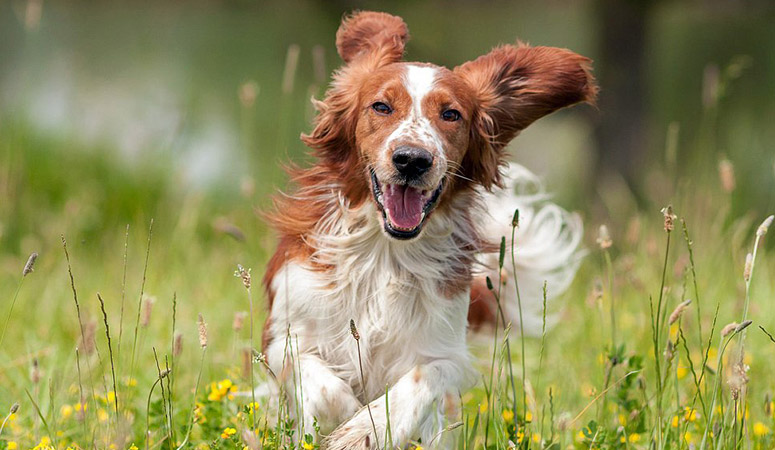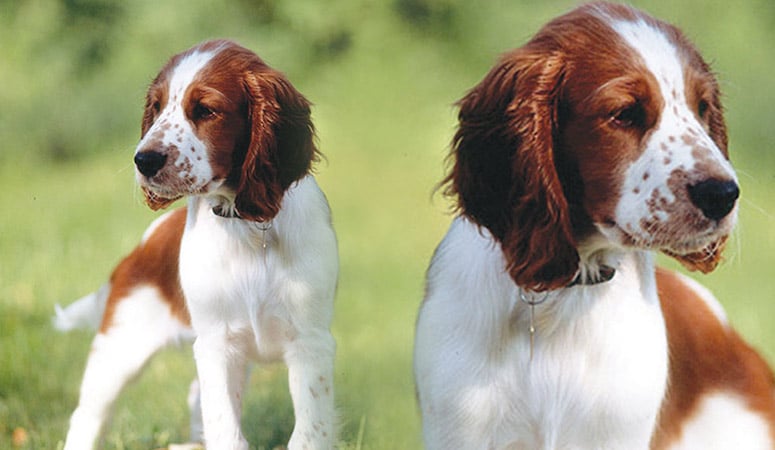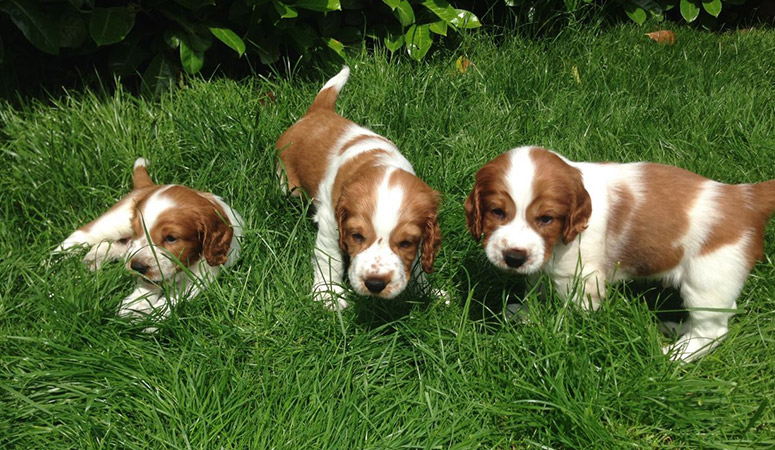Welsh Springer Spaniel

The Welsh Springer Spaniel has a uniquely tapered head and an eye-catching coat of bold red and white patterns, which distinguish them from other spaniels. With a muscular build, this breed is a loyal retriever with energy to spare. They are loving and loyal with their family, but decidedly reserved with strangers.
| Other Names | Welsh Springer, Welsh Starter |
| Color | Red & White |
| Height | Males: 18-19 inches. Females: 17-18 inches. |
| Weight | Males: 35-45 pounds. Females: 35-45 pounds. |
| Life Span | 12-15 years |
| Personality | Happy, Reserved, Upbeat |
| Exercise | Needs Lots of Activity |
| Origin |
| Popularity | #130 |
| Groom Needs | Weekly Brushing |
| Kids Friendly | Yes |
| Dog Friendly | Yes with supervision |
| Watch Dog | |
| Family Dog | |
| Litter Size | 6-8 puppies |
Welsh Springer Spaniel Pictures
Welsh Springer Spaniel Video
Introduction
The American Kennel Club (AKC) placed them as members of the Sporting Group. However, Welsh Springer Spaniels are a breed of dogs with a happy disposition, and yet a tendency to recluse into themselves. They are medium-sized dogs bred originally for their springing abilities (that is, they are bird dogs). They come with a tapered head that distinguishes them from most other spaniels. Normally, they have a straight and soft coat which is never wiry. This coat is usually white and red in color, according to acceptable standards.
Being medium-sized dogs, Welsh Springer Spaniels stand close to 19 inches at the shoulder, although the females run quite smaller in size. A full-grown male weighs around 40-55 pounds, while a similar female packs a lesser pound weight of 35-50. Welsh Springer Spaniels are one of England’s oldest spaniels. They have an average lifespan of 12-16 years.
Living with Welsh Springer Spaniel
The luxurious coat of the Welsh Springer Spaniel is decidedly low-maintenance. To keep his attractive red-and-white coat looking its best, the dog needs at least weekly grooming. A good once-over with a soft brush should work well for this, along with a slicker brush or metal dog comb to work apart any mats or tangles that are starting to form.
Brush them regularly to keep them looking their best and to prevent mats, which are especially common when they’re shedding. Bathe them with a gentle shampoo meant for dogs only when necessary to keep the coat and skin clean and healthy.
The nails should be trimmed every three to four weeks to prevent painful cracking.
Brush the teeth at least once per week to prevent tartar buildup and fight gum disease.
Because their ears hang down, you need to check your Welshie’s ears and clean them at least once a week to prevent ear infections. Cleanse regularly with a veterinarian-approved cleanser and cotton ball.
Welsh Springer Spaniels are athletes and they have loads of energy. This breed is very intelligent and needs to have his mind stimulated as well as his body. A healthy Welsh Springer Spaniel requires about two hours of physical activity each day. This may include field training, hunting, agility training, fetch, brisk walks, or a combination of these activities.
Welsh Springer Spaniels should spend several hours outdoors each day, playing and training. It’s helpful to have an enclosed yard where they can run and play catch and otherwise expend excess energy. But they should never be left outside by themselves, as they will search for a way out and bark at every passing bird.
Toys that keep the dog thinking are essential for the Welsh Springer Spaniel. Those that hide treats inside are truly beneficial. And the toys should be left out whenever the dog is left alone or he can become destructive.
Play sessions with their family in a securely fenced yard or long daily walks with their owner work well. And interaction with their humans is the key to a happy Welshie.
This breed will happily flush birds from your yard or playfully romp around chasing a tennis ball. The Welsh Springer Spaniel and the kids will be tuckered out and dosing off on the couch by the end of the night.
Known for exuberance, especially as puppies, the Welsh Springer Spaniels need lots of interaction with their families and should live indoors with them. Be careful where you place your breakables.
Generally, this breed requires about 1.5 to 2.5 cups of good quality dry dog food each day, given in two feedings. But this will vary with your Welshie’s activity level, size, metabolism and age.
The quality of dog food you buy also makes a difference — the better the dog food, the further it will go toward nourishing your dog.
Talk to your veterinarian about the optimal diet and quantity of food for your Welsh Springer Spaniel.
Some dogs are prone to getting overweight, so watch your dog’s calorie consumption and weight level. Treats can be an important aid in training, but giving too many can cause obesity.
Clean, fresh water should be available at all times.
Learn about which human foods are safe for dogs, and which are not. Check with your vet if you have any concerns about your dog’s weight or diet.
Welsh Springer Spaniels are generally healthy dogs, but just like all breeds, they sometimes may suffer from some health conditions, such as hip and elbow dysplasia, epilepsy, autoimmune thyroiditis and entropion (a condition in which the lower eyelid folds in and causes irritation), etc.
Some health problems don’t appear until a dog reaches full maturity. Not all Welsh Springer Spaniels will get any or all of these diseases, but it’s important to be aware of them if you’re considering this breed.
A Welshie’s ears should be checked regularly for signs of infection, and the teeth should be brushed often, using a toothpaste formulated for dogs.
There are several health tests considerations specific to the breed, such as hip evaluation, elbow evaluation, ophthalmologist evaluation and thyroid evaluation.
Responsible breeders test all breeding stock for conditions that can affect the breed. Regular visits to the vet for checkups and parasite control help to ensure the dog a long, healthy life.
Total Annual Cost: $2889
Cost is estimated for the first year and may vary depending on many factors, such as dog food, health care, leash, collar, licensing, possible fencing, crates, training and obedience classes, dog-walking, grooming, treats, toys, flea, tick, and heart-worm meds, microchips, etc.
Welsh Springer Spaniels require a gentle touch when it comes to training or they may choose to ignore every command. Their energy, intelligence, and need for industry make Welshies excellent candidates for all varieties of advanced training, including obedience, dog sports, and agility.
The Welsh Springer tends to be “reserved with strangers,” to quote the breed standard. This should not be taken to mean a Welshie is timid or shy.
Welsh Springer Spaniels are bred for the field and make excellent upland hunters. Though they are considered ‘land spaniels,’ they are versatile enough to retrieve waterfowl.
Early socialization and puppy training classes are essential. Keep in mind that Welshies are hunting dogs, and the urge to chase birds and small mammals has been bred into them.
Most puppies learn quickly to respect your pet cat or another dog, however. A securely fenced yard is best.
Keep training sessions short and positive. That’s more suited to their personality and attention span than boring repetition. Train them with understanding and patience, and you’ll be well rewarded.
History
The Welsh Springer Spaniel has been, over time, described under different names in a different era. At some point, they were known as the Welsh Starter, when they were popular as springing dogs, at another time they were called the Welsh Spaniel. It is known that the Kennel Club had once registered Welsh Springer Spaniels as Cocker Spaniels in its Studbook. The history of the Welsh Springer Spaniel is not exactly easy to place, although it is believed that they had evolved from red and white types of Land Spaniels which made their way into the Welsh valley some years ago. Historians agree that these Land Spaniels which had been depicted in paintings and old artworks share marked resemblance with modern Welsh Springer Spaniels, even in their coat color.
The breed remained in a state of obscurity all through the 1800s, and it wasn’t until the period leading up to the 20th century that they came into the limelight. Mr. A. T. Williams of Ynis-y-Gerwn was credited with the rise of the Welsh Springer Spaniel to fame with his dog team’s escapades at the Sporting Spaniel Club Trials in 1900. Afterward, the breed was recognized by the Kennel Club in 1902, as the Welsh Springer Spaniel.
Welsh Springer Spaniels were imported into the U.S in the 19th century, rose to fame quickly, and gained AKC (American Kennel Club) recognition in 1906. World War I brought the breed to its knees, leaving in its wake Welsh Springer Spaniels, whose parents didn’t have a registered pedigree. Breeders of the 1920s and 1930s rose to the occasion to breed the remaining unregistered dogs into what we know today as the modern Welsh Springer Spaniel. A breed club, the Welsh Springer Spaniel Club, was established in the United Kingdom, in 1923.
Helpful Information
Breed Club: WELSH SPRINGER SPANIEL CLUB OF AMERICA, INC.
Breed Club Link: https://www.wssca.com/
Breed Club Rescue: WSSCA Breed Rescue
Breed Club Rescue Link: https://www.wssca.com/html/wsscaRescue.html




